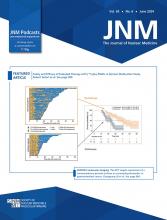REPLY: We appreciate the opportunity to respond to the commentary on our paper (1) by Dr. Beattie and to offer additional perspective on the topic of artificial intelligence (AI)–based PET and SPECT image enhancement.
Our article at no point suggested that AI is clairvoyant. Years of research before the introduction of AI models show that image enhancement techniques, including image denoising and partial-volume correction approaches, can lead to improved performance in terms of both image-based quantitative metrics and clinical tasks, such as lesion detectability (2,3). Although the advent of AI techniques has greatly expanded this arsenal, the general idea that improvements in resolution and noise could facilitate image interpretation predates the introduction of AI models to medical imaging.
Regularizers and priors tend to infuse some bias while reducing the variance. Instead of attempting to generate zero bias, which is a lofty goal, the PET image reconstruction community has traditionally relied on bias-variance studies that seek to identify as the winner a method that produces the lowest bias among a pool of competing approaches. We posit that AI-based image generation approaches for nuclear medicine could benefit from rigorous handling through bias-variance analyses (4).
Dr. Beattie raised concerns about learning from a population instead of a person. Fundamentally, priors rely on information that is not captured by the data. Many regularization techniques achieve this by encouraging certain local or nonlocal characteristics in an image (e.g., smoothness, edge preservation, sparsity in another domain, and cross-modality similarity). Bayesian approaches, on the other hand, assume knowledge of the prior distribution of the unknown variable or image. Deep neural networks are no different from these other non-AI methods in that they rely on inductive biases acquired from a training dataset to achieve good generalization in the validation cohort. Furthermore, many unsupervised or zero-shot image enhancement techniques use only the corrupt image for model training and do not rely on a population. Examples include the deep image prior, which leverages inductive biases intrinsic to deep convolutional architectures (5), and the Noise2Void approach, which uses blind-spot masking (6).
The relative merits and demerits of reconstruction-based approaches versus their postreconstruction counterparts raised by Dr. Beattie are also not specific to AI models. Regularizers and priors incorporated within reconstruction tend to be quantitatively more accurate than those used in denoising or deblurring frameworks applied after reconstruction. However, these methods have limited use for vast swaths of existing imaging data for which raw projection datasets may not be available. Since AI models heavily rely on data volume and variety, there is both a justifiable need for and interest in developing AI-based postreconstruction image enhancement approaches.
Hallucinations in AI-generated synthetic images are a justifiable concern of Dr. Beattie’s. Notably, these are a threat to both reconstruction-based and postreconstruction AI methods alike (7). The only way to address these concerns is through a rigorous combination of image-based validation (where ground truth information is available and used to detect synthetically introduced spurious features) and clinical task-based validation that can affect the potential impact on clinical decision-making.
The medical imaging community has been empowered by AI tools relatively recently, and it is critical to use these methods responsibly and in ways that maximize clinical benefit. In conclusion, therefore, we would like to reiterate a key premise of the review article that image quality metric–based validation and clinical task–based validation need to go hand in hand to ensure the robustness and trustworthiness of AI approaches applied to clinical medicine.
DISCLOSURE
Joyita Dutta received NIH funding (grants R01AG072669 and R03AG070750) for AI. No other potential conflict of interest relevant to this article was reported.
Joyita Dutta,* Vibha Balaji, Tzu-An Song
University of Massachusetts Amherst, Amherst, Massachusetts
*E-mail: jdutta{at}umass.edu
Footnotes
Published online May 2, 2024.
- © 2024 by the Society of Nuclear Medicine and Molecular Imaging.
REFERENCES
- Revision received April 6, 2024.
- Accepted for publication April 18, 2024.







